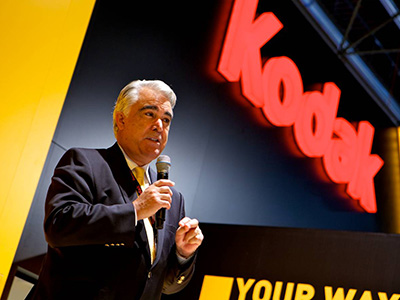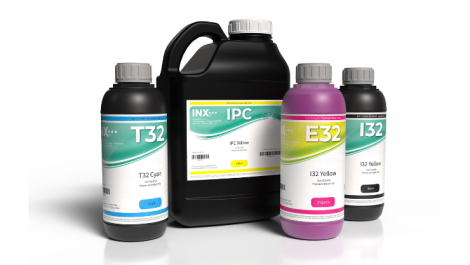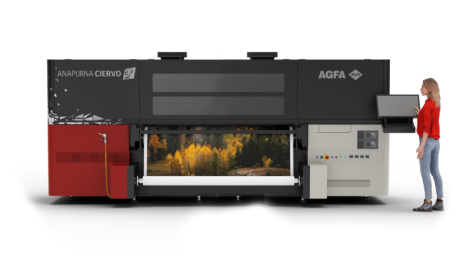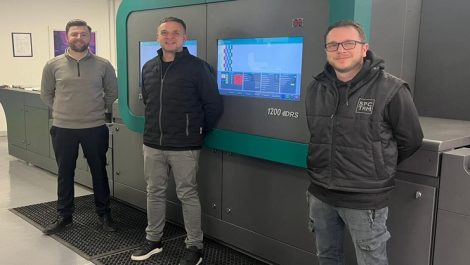Kodak is planning to sell off its iconic consumer film business, the flagship of the company since its foundation in 1889.
It said that in future it will concentrate on its high end digital press business, as well as offset and flexo films and plates, plus its still lucrative movie film business. It’s also selling off its high street kiosk imaging and printing business, plus the related souvenir photography business for theme parks and the like, as well as document imaging, its business scanning operation.
The company described this as taking ‘the next steps toward a successful emergence from Chapter 11 reorganisation as a company primarily focused on commercial, packaging and functional printing solutions and enterprise services.’
What’s up for sale are the Personalized Imaging department, which includes consumer films and photo papers, picture kiosks, and souvenir photo products, plus the Document Imaging department, which handles scanners for business documents.
Last year these were responsible for about 40% of the company’s total revenues, though those famous yellow boxes of film are only now responsible for a fraction of this. The real revenue is in the output side of Personalized Imaging, the silver halide photo papers and chemistry that are still used for colour prints even though the lab exposure systems are now digital.
It’s even possible that the sale will include the rights to use the Kodak name and presumably the yellow boxes, on photographic products. An unnamed Kodak spokesperson floated that possibility in a news report in the British Journal of Photography, although Chris Payne, the company’s marketing director for commercial business, told Digital Printer that it’s far to early to comment on what the terms of any deal may be.
Kodak said it will continue to own the commercial, packaging and ‘functional printing’ and enterprise services businesses, as well as the Consumer Inkjet, Entertainment Imaging, Commercial Film and Specialty Chemicals businesses. It referred to its ‘expertise, capabilities and strong customer relationships in these markets, as well as their combined cash-generating capability.’
What could be termed the ‘graphic arts,’ professional print part of its business, ie digital presses, offset and flexo plates and associated support elements, earned around $2.1 billion last year, of which digital presses were responsible for around $600 million.
Kodak entered the US Chapter 11 bankruptcy procedures in January, which allows it to trade while seeking to restructure its business. It said it is still planning to emerge from Chapter 11 at some time next year: it needs to present a restructure plan by February under the terms of its Chapter 11 protection. It said it hopes to sell off the Personalized Imaging and Document Imaging business in the first half of 2013.
How attractive the Personalized Imaging business would be, and to what sort of buyer, is uncertain. Fujifilm is the only remaining consumer film maker of comparable size and may not be interested, but purchases of this size are often handled by faceless investment corporations.
Antonio M Perez, Kodak’s chairman and CEO (pictured above), is presenting the sale as a viable on-going business that could be self-contained: ‘Personalized Imaging and Document Imaging are valuable businesses that enjoy leading market positions as a result of superior products and service offerings. We remain steadfast in our commitment to our customers, and we will work to ensure that they continue to receive the exceptional levels of quality and service they have come to expect from Kodak. Customers remain the top priority of all our businesses – those we intend to sell and those that will remain part of Kodak.’
The past few years has seen Kodak downsize dramatically, shedding jobs, factories and whole operating sectors (notably medical imaging and digital cameras), with a consistent aim to build up a business in digital printing. Non-specialist commentators have tended to focus on the company’s moves into consumer desktop printers, but actually its real interest and prospects are in the high end printing sector, particularly with its new generation Stream inkjet heads and the Prosper family of printers that these are built into.
To raise cash in the meantime, it has for several years been trying to capitalise on its extensive patents portfolio, especially in digital imaging. This is potentially worth billions of dollars from the mass market for cameras in mobile phones. However, so far the takeup hasn’t been what the company hoped. Originally it hoped to raise revenue by a combination of licensing the patents to third parties, and suing alleged infringers (which were sometimes the same third party). The company said it had earned $3 billion from licenses over the past decade, but its losses mounted up faster. It then tried to sell the patents outright, but takeup, particularly last year, wasn’t as high as it hoped for.
It appears that the Chapter 11 move was partly to gain more time to sell off the patents, but also to pre-empt some legal issues that were apparently putting others off from buying the patents at the time. Rumours in the financial press this summer, which Kodak isn’t commenting on, are that its attempt to auction off its patents isn’t doing very well, with the likes of Apple, Google and Samsung allying to bid collectively, which would tend to keep the price down.
These companies, it should be noted, are elsewhere suing each other energetically in courts all over the world. Indeed Apple recently won a significant judgement against Samsung about tablets (unsurprisingly, Samsung is appealing against it). In July Apple lost an attempt to stop Kodak selling some patents on technologies that Apple already laid claim to. Apple is now appealing that.
Meanwhile Kodak is now saying that although its patents portfolio is still up for sale, it may keep some or all of it ‘as an alternative source of recovery for creditors.’
‘The initiation of a process to sell the Personalized Imaging and Document Imaging businesses is an important step in our company’s reorganization to focus our business on the commercial markets and enable Kodak to accelerate its momentum toward emergence,’ said Mr Perez. ‘In addition, we continue our initiatives to reduce our cost structure and streamline our operating models in an effort to return the company to profitability.
‘We are reshaping Kodak. We continue to rebalance our company toward commercial, packaging and functional printing – in which we have the broadest portfolio solutions – and enterprise services. These businesses have substantial long-term growth prospects worldwide and are core to the future of Kodak. We are confident that our competitive advantages in materials science and deposition technologies, as well as our know-how in digital imaging, will enable us to capitalise on those opportunities and extend our leadership in key growth markets.’
Contact: www.kodak.com





